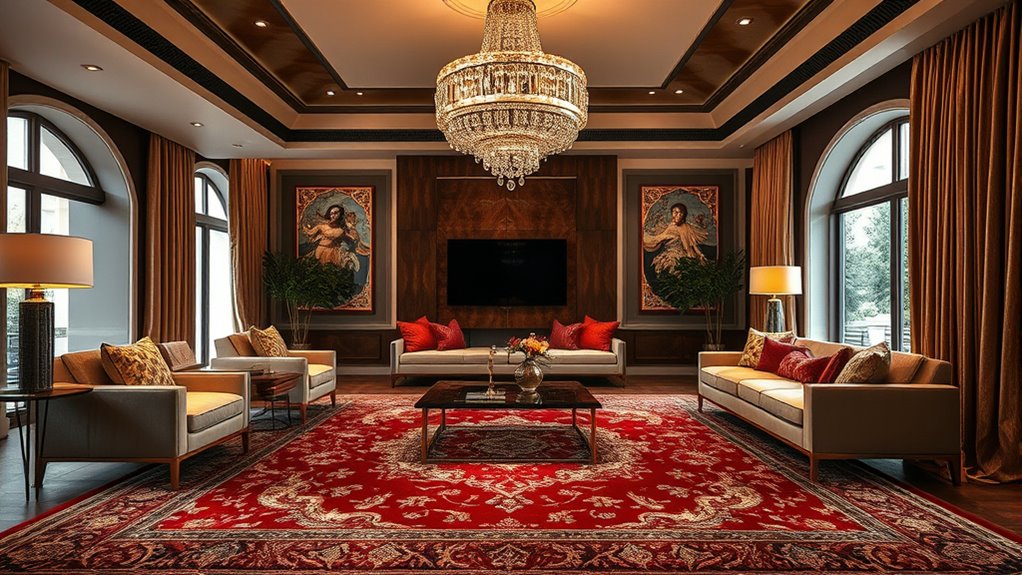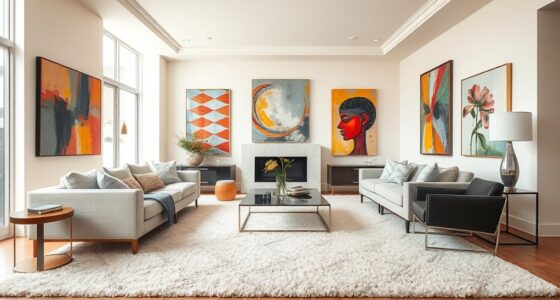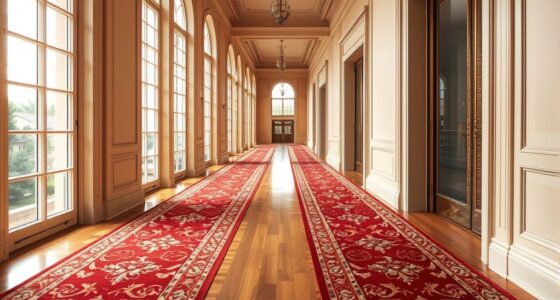When pairing rugs with statement lighting fixtures, focus on balancing texture, color, and scale for a cohesive look. Opt for rugs that complement or contrast your fixture’s style and hues to create visual interest. Match textures — plush with warm lighting or woven with minimalist fixtures — and keep proportions in harmony to avoid overwhelming the space. Want tips on making your interior truly stand out? Keep exploring for more expert guidance.
Key Takeaways
- Match rug patterns and textures with the style and finish of statement lighting to create visual harmony.
- Consider the room’s overall decor style when pairing bold rugs with statement fixtures for cohesive aesthetics.
- Use scale and proportion to balance large rugs with oversized lighting fixtures and delicate rugs with smaller fixtures.
- Incorporate complementary or contrasting colors to enhance visual interest and highlight key design elements.
- Ensure lighting placement highlights the rug’s texture and pattern, creating a focal point and enriching the room’s ambiance.
Understanding the Role of Rugs and Lighting in Interior Design
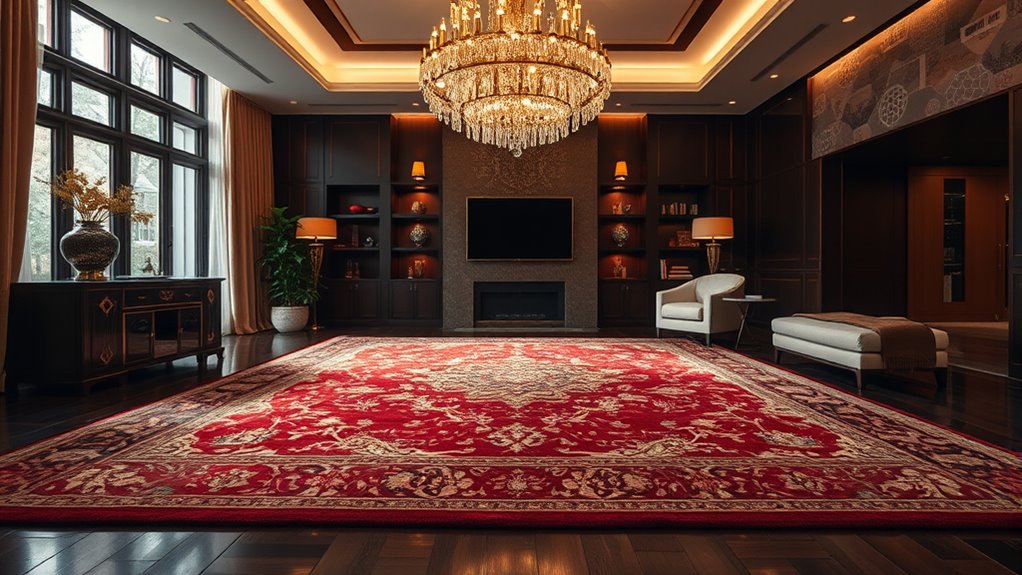
Rugs and lighting are fundamental elements that shape the atmosphere and style of a room. They work together to create an ambient glow that sets the mood and highlights your decor. A well-chosen rug adds warmth and texture, serving as a decorative accent that anchors your space. Meanwhile, statement lighting fixtures draw attention and add personality, casting light that enhances your room’s features. By understanding how these elements interact, you can craft a cohesive look that reflects your style. When you pair a striking rug with the right lighting, you elevate the overall ambiance, making your space inviting and visually appealing. Both rugs and lighting serve as essential tools to express your personality and refine your interior design. Additionally, considering the seasonal variations can help you select the most appropriate textures and lighting effects to suit different times of the year.
Choosing the Right Rug for Your Statement Lighting
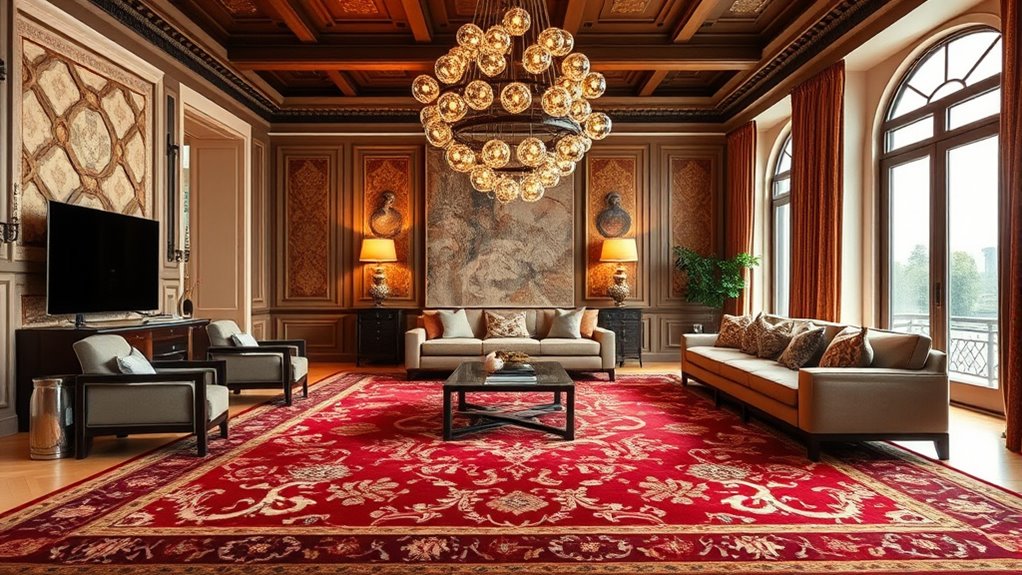
When selecting a rug to complement your statement lighting, consider how the colors, patterns, and textures interact with the fixture’s design. Aim for pattern contrast to create visual interest; if your lighting fixture is sleek and modern, choose a rug with bold, geometric patterns. Conversely, if your fixture is ornate, opt for simpler designs to avoid visual clutter. Material harmony is equally important—match the rug’s texture with the lighting’s style to unify the space. For example, a plush rug pairs well with warm, ambient lighting, while a sisal or jute rug complements minimalist fixtures. Balancing contrast and harmony ensures your rug and statement lighting work together, enhancing your room’s overall aesthetic without competing for attention. Additionally, understanding sound vibrations can inspire choices that promote a calming environment, subtly influencing how the space feels.
Selecting the Perfect Statement Lighting Fixture for Different Room Styles
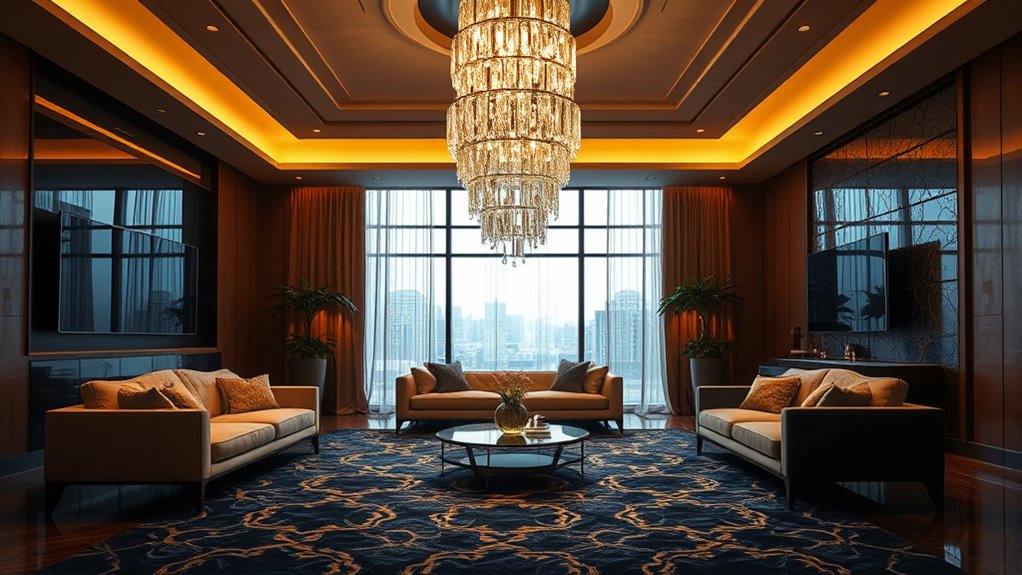
Choosing the right statement lighting fixture depends on your room’s style and function. You want a piece that complements your decor and enhances the space’s purpose. By matching fixture styles and considering how the room is used, you create a cohesive and inviting environment. Additionally, being aware of store hours can help you plan your visits for in-person shopping or consultations.
Matching Fixture Styles
Matching fixture styles to your room’s overall design guarantees your statement lighting complements the space rather than competes with it. When you match aesthetics, you create a harmonious environment that feels intentional and cohesive. Think about the vibe you want: modern, rustic, vintage, or eclectic? Your fixture styles should reflect that. For example, sleek glass fixtures suit contemporary rooms, while ornate chandeliers fit traditional spaces. Here’s a quick guide:
| Style | Fixture Types | Ideal Room Feel |
|---|---|---|
| Modern | Minimalist pendant | Sleek, clean lines |
| Rustic | Wrought iron fixtures | Cozy, warm vibe |
| Vintage | Brass chandeliers | Nostalgic charm |
| Eclectic | Mixed materials | Unique, personalized |
In addition, considering the aesthetic harmony of your space can help ensure your lighting makes a balanced statement without overwhelming other design elements.
Room Function Considerations
Selecting the right statement lighting fixture depends heavily on the room’s primary function, as different spaces require different levels of illumination and styles to suit their purpose. For example, a dining room benefits from a dramatic chandelier that complements its architectural style, while a cozy living room might call for softer, layered lighting. Consider how seasonal decor influences your fixture choices—adding warm tones for winter or brighter accents for summer. In kitchens or workspaces, functional yet stylish fixtures are essential, aligning with the room’s purpose. Architectural styles also guide your selection; modern spaces favor sleek designs, whereas traditional rooms look better with ornate fixtures. By matching your lighting to the room’s function, you enhance both aesthetics and practicality. Additionally, understanding interior design basics can help you create a cohesive look that balances beauty and practicality throughout your space.
Color Coordination: Harmonizing Rugs and Lighting
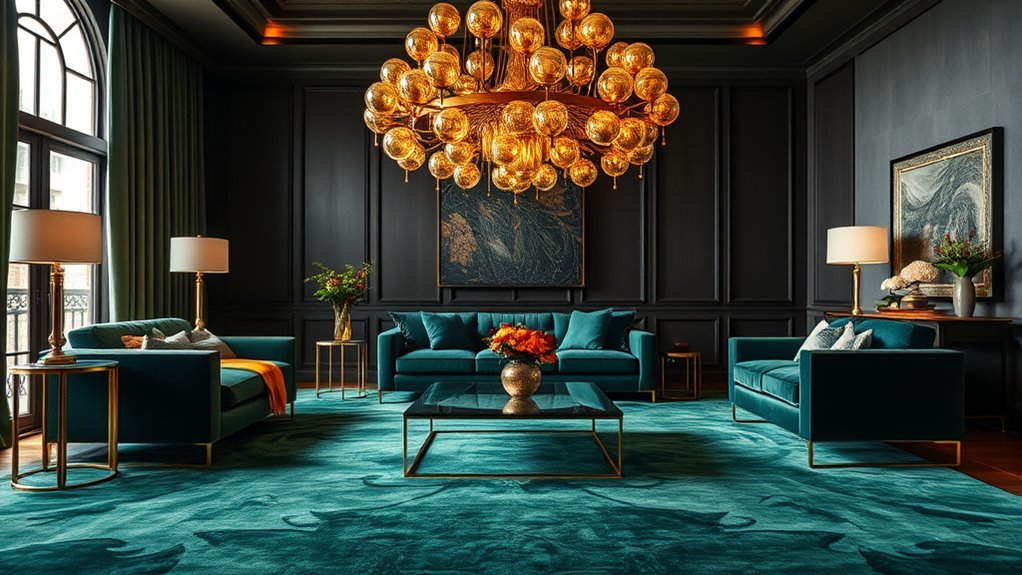
You can create stunning visual harmony by choosing complementary color schemes that tie your rug and lighting together. Alternatively, using contrasting colors can make each element stand out and add energy to your space. Understanding how these color effects work helps you craft a balanced and eye-catching room. Considering the overall style of your decor, such as aesthetic modifications, can further enhance the cohesiveness of your design.
Complementary Color Schemes
Have you ever wondered how to create a cohesive look by pairing your rug with statement lighting? Complementary color schemes can help you achieve this by emphasizing color harmony and mood enhancement. Choosing colors opposite on the color wheel creates vibrant contrasts that energize your space. To make the most of this approach:
- Use a bold rug with a softer, complementary light fixture for balance
- Opt for warm-colored rugs with cool-toned lighting to evoke calmness
- Incorporate accent pillows or art in complementary hues for layered depth
- Consider the room’s overall mood when selecting contrasting shades
- Understanding color coordination principles can further refine your design choices.
Contrasting Color Effects
Contrasting color effects can dramatically enhance your space by creating visual interest and depth. By pairing rugs and lighting with vibrant contrasts, you draw attention and add energy to the room. Conversely, subtle harmony offers a softer, more cohesive look. To achieve this balance, consider the following options:
| Rug Color | Lighting Fixture | Effect |
|---|---|---|
| Deep blue | Warm amber | Vibrant contrast |
| Soft beige | Cool white | Subtle harmony |
| Rich red | Gold accents | Dramatic vibrancy |
Using bold and muted tones together, you emphasize your space’s personality while maintaining visual balance. Contrasting colors make your decor pop, but be mindful to blend hues thoughtfully for a harmonious look. Additionally, understanding contrast ratio helps optimize how these color pairings appear to ensure your design remains balanced and visually appealing.
Texture and Material Pairings for a Cohesive Look
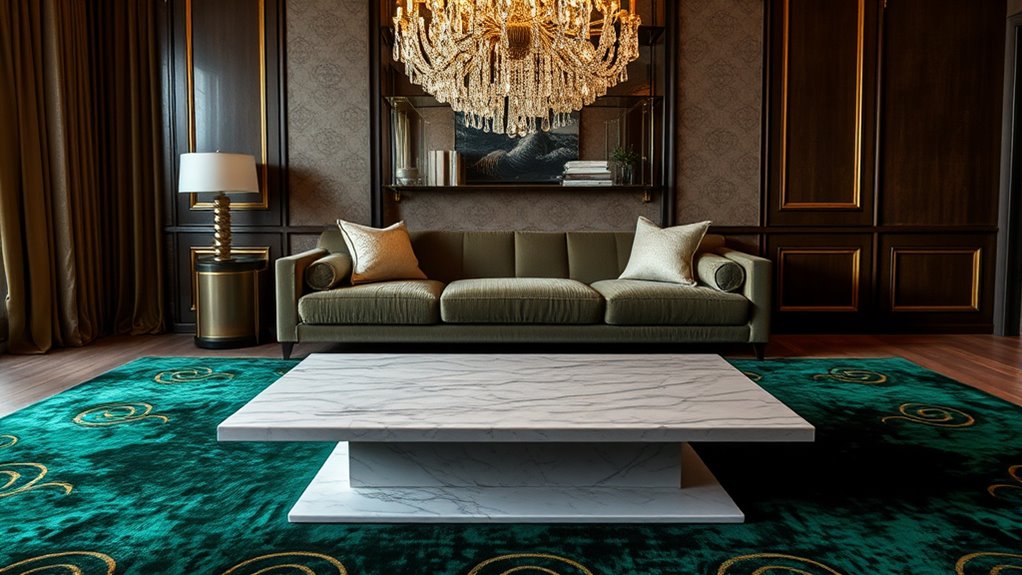
Achieving a cohesive look when pairing rugs with statement lighting hinges on thoughtfully selecting textures and materials that complement each other. Your goal is to create harmony through fabric textures and material finishes that enhance both elements. For example, pairing a plush, velvety rug with a sleek, polished metal fixture can add contrast, while matching a woven rug’s texture with matte or brushed finishes creates unity. Consider these tips:
- Combine soft, tactile fabric textures like wool or shag with matte or satin finishes on fixtures
- Use smooth, shiny materials such as glass or polished metal to balance textured rugs
- Mix natural fibers like jute or sisal with rustic or matte lighting fixtures
- Opt for textured rugs that mirror the material finish of your lighting for seamless cohesion
- Incorporating waterproof or water-resistant materials in your decor can also enhance durability and style, especially in high-moisture areas.
Creating Focal Points With Rug and Lighting Combinations

Creating focal points with rug and lighting combinations transforms a space into an eye-catching area that draws attention and defines the room’s character. To achieve this, select a statement lighting fixture that complements your rug’s pattern and color. Use the ambient glow from your lighting to highlight decorative accents on the rug or nearby furniture. Position the light fixture to cast a gentle, inviting light that emphasizes the rug’s texture and design. This pairing naturally draws the eye and creates a cohesive aesthetic. Consider this table for inspiration:
| Rug Pattern | Lighting Style | Decorative Accents |
|---|---|---|
| Geometric | Pendant with warm glow | Metallic vases |
| Persian | Chandelier with dimming | Textured pillows |
| Solid Color | Floor lamp with soft light | Artistic sculptures |
| Abstract | Wall sconces with ambient glow | Candles |
| Natural Fiber | Table lamp with diffused light | Wooden trays |
Additionally, incorporating mindful decluttering can help you curate a space that highlights your chosen rug and lighting, making the focal point even more striking.
Balancing Scale and Proportion in Rug and Light Fixture Pairings

When pairing rugs with light fixtures, it’s essential to take into account their scale and proportion to guarantee a balanced look. Achieving scale harmony means selecting pieces that complement each other without overpowering or shrinking the space. Proportion balance involves considering the size of the room and furniture to match the rug and fixture appropriately.
Pair rugs and light fixtures by balancing scale and proportion for a harmonious space.
Keep these tips in mind:
- Choose a large rug for oversized fixtures to prevent visual imbalance
- Opt for a smaller rug with a delicate fixture to avoid overwhelming the space
- Match the rug’s pattern size with the fixture’s design details
- Ensure the height of the fixture aligns with the rug’s scale for cohesive visual flow
Balancing scale and proportion creates a harmonious, inviting environment.
Tips for Maintaining Visual Balance and Avoiding Overload

To maintain visual balance and prevent overload in your space, it’s important to carefully consider how your rug and lighting work together. Too many bold patterns or bright fixtures can create visual clutter, making the room feel chaotic. To avoid sensory overload, choose statement lighting that complements your rug without competing for attention. Keep the overall look cohesive by balancing scale and avoiding excess decoration. Use lighting to highlight key areas without overwhelming the space. Stick to a consistent color palette and simple design elements to maintain harmony. Remember, less is often more—allow each piece to stand out without competing. By thoughtfully pairing your rug and lighting, you create a welcoming, balanced environment free of visual clutter and sensory overload.
Frequently Asked Questions
How Can I Combine Vintage Rugs With Modern Lighting Fixtures Effectively?
You can create a stunning space by blending vintage rug pairing with modern lighting design. Start by choosing a vintage rug with bold patterns or rich textures to add character. Then, select sleek, contemporary lighting fixtures that complement the rug’s colors or style. Keep the rest of your decor minimal to let the vintage rug and modern lighting stand out, achieving a balanced, stylish look that feels both fresh and timeless.
What Are the Best Lighting Options for Small or Low-Ceiling Rooms?
Ever notice how small or low-ceiling rooms can feel cramped? You can make them seem more spacious by choosing the right lighting. Opt for ambient lighting to brighten the entire space evenly, and add accent fixtures like wall sconces or mini pendants to create depth and interest without overwhelming the room. These options help open up your space, making it feel larger and more inviting.
How Do I Incorporate Bold-Patterned Rugs Without Overwhelming the Space?
To incorporate bold-patterned rugs without overwhelming your space, focus on pattern balancing and color coordination. Choose a rug with a striking pattern but keep your furniture and walls in neutral tones to avoid visual clutter. Use subtle accessories that complement the rug’s colors, creating harmony. This approach guarantees your space feels lively yet balanced, allowing the statement rug to shine without overpowering the room’s overall aesthetic.
What Lighting Styles Complement Minimalist or Scandinavian-Designed Rugs?
Imagine your space as a calm lake, where minimalist or Scandinavian rugs act like gentle ripples. To enhance this serenity, choose ambient lighting that mimics soft sunlight—think warm, diffused fixtures. Opt for lighting styles with sleek lines and neutral tones, which naturally complement the understated elegance of your rugs. Focus on color coordination, ensuring the light’s hue and intensity harmonize with your rug’s subtle tones, creating a balanced, tranquil atmosphere.
How Can I Adjust Lighting and Rugs for Seasonal or Temporary Decor Changes?
When adjusting lighting and rugs for seasonal decor or temporary updates, you can easily switch out rugs to reflect the season, like cozy wool for winter or light cotton for summer. Pair these with adjustable or dimmable lighting to create the right ambiance. Use warm bulbs for winter warmth or cooler ones for summer freshness. This flexibility helps you effortlessly refresh your space for each season or temporary change.
Conclusion
Remember, when pairing rugs with statement lighting, it’s all about balance—unless you’re aiming for chaos, then go wild. Think of your space as a carefully curated circus act: too many shiny things and you’ll have a spectacle no one can focus on. So, resist the urge to turn your room into a disco ball factory. Keep it harmonious, and let your lighting and rugs do the dancing—without tripping over each other.
